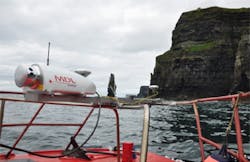Irish cliffs surveyed with Lidar
When chartered land surveyors at Coastway (Co. Kildare, Ireland) were given the task of laser scanning and producing a 3-D model of the cliffs of Moher on the western seaboard of County Clare Ireland, they approached Measurement Devices Ltd (MDL; York, England) to assist them with the task.
MDL proposed a solution using its Dynascan 3-D mobile mapping system with a laser accuracy of +/-50 mm and a range of up to 500m that can be mounted on both vehicles and vessels and used to capture 3-D Lidar data.
The unit and secondary GPS antenna were mounted on a boom at the front of a fishing boat allowing a sufficient field of view for the 360 degree Scanning Laser Module (SLM) to survey the cliff. In addition to the SLM the Dynascan contains a high grade Inertial Measurement Unit (IMU) consisting of gyroscopes and accelerometers that works to compensate for the motion, pitch and roll of the boat.
Accurate 3-D positioning was achieved using the built in Real Time Kinematic (RTK) differential GNSS systems, which employ GNSS carrier phase differential techniques to provide real-time, centimeter-level, 3-D positioning. RTK correction signals where derived from a local RTK Base Station that was set up over a known Survey Control Point on the cliff top. The computed correction signals where then transmitted to the mobile GNSS receivers on the Dynascan over a UHF Radio Link. The raw data was also logged to be used for post processing in case of RTK shadow near the cliff and as a quality assurance measure.
Qinsy acquisition software was used to provide data processing and visualisation of the acquired data allowing for coverage and quality to be verified during the survey. In addition to the laser point cloud photography was captured using a standard digital SLR camera.
Approximately 2km of the cliff face was surveyed over seven passes in different directions to ensure full coverage of the varied contours of the cliff face and bays. The actual survey data took less than hour to acquire.
On completion of the vessel survey, the system was transferred onto a vehicle and used to capture the topography on the top of the cliff. The data was collected on the same grid allowing for seamless integration between the two data sets.
The geo-referenced point cloud was then handed over to Coastway for post processing. The initial data was imported into Leica Cyclone point cloud processing software. The data was reviewed and cleaned, producing a point cloud ready for mesh creation. The final data set was exported to a XYZ text file and imported into 3-D modelling software package.
Within some of the bays there was a shallow reef meaning the boat could not get close enough to scan parts of the cliff face leading to some gaps with the laser data. Coastway therefore used the photos acquired and Autodesk 123D software to create a 3-D model to fill in the gaps. The combined cloud was remeshed creating a seamless model of the cliff face. The high resolution image was used to 'bake' the imagery onto the final mesh model.
Finally the 3-D model was rendered with the imagery acquired and a fly through animation produced using 3-D visualisation software.
Related articles from Vision Systems Design you might also find of interest.
1. Lidar unveils possible Honduran archaeological ruins
A team from the University of Houston (UH; Houston, TX, USA) and the National Science Foundation (NSF) National Center for Airborne Laser Mapping (NCALM; Houston, TX, USA) has mapped a remote region of Honduras that may contain the legendary lost city of Ciudad Blanca.
2. Lidar optimizes wind turbine output
Working with engineers from the National Renewable Energy Laboratory (NREL; Boulder, CO USA), scientists from the University of Stuttgart (Stuttgart, Germany) have developed a control system that can optimize the energy extracted from wind turbines.
-- Dave Wilson, Senior Editor, Vision Systems Design
